Sn2 reactions Study guides, Class notes & Summaries
Looking for the best study guides, study notes and summaries about Sn2 reactions? On this page you'll find 127 study documents about Sn2 reactions.
Page 3 out of 127 results
Sort by
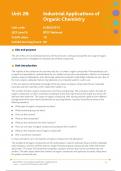
-
Industrial Applications of Organic Chemistry
- Exam (elaborations) • 14 pages • 2024
-
- $8.99
- + learn more
Unit 28: Industrial Applications of Organic Chemistry Unit code: H/502/5573 QCF Level 3: BTEC National Credit value: 10 Guided learning hours: 60 Aim and purpose The aim of this unit is to familiarise learners with the structure, naming and properties of a range of organic compounds and to investigate the industrial uses of these compounds. Unit introduction The majority of the substances we use every day are, or contain, organic compounds. Pharmaceuticals such as aspirin and parac...

-
Organic Chemistry - Final Exam 100% Correct!!
- Exam (elaborations) • 6 pages • 2024
-
Available in package deal
-
- $15.49
- + learn more
Name the 6 polar aprotic solvents - ANSWERacetone, acetonitrile, DMSO, DMF, HMPA, THF Name the 5 polar protic solvents - ANSWERacetic acid, ethanol, formic acid, methanol, water ______ and ______ mechanisms are two step reactions that have _____ intermediates. - ANSWERSN1; E1; 2 Intermediates each ______ and ______ mechanisms are one step reactions that have _____ intermediates. - ANSWERSN2; E2; 1 Intermediate each Allylic - ANSWERresonance stabilized (carbon bonded directly to a C=C...

-
CHEM 243-002: Organic Chemistry I
- Exam (elaborations) • 6 pages • 2024
-
- $15.49
- + learn more
COURSE INFORMATION Course Description: This is part I of a two semester course in Organic Chemistry for chemistry or non chemistry majors. Outcomes of the course are given below Number of Credits: 3 Prerequisites: Undergraduate level chemistry 126, minimum grade C. Course-Section and Instructors Course-Section Chem 243 - 002 Dr. Tamara Gund Instructor Chem 243 -102 Office Hours for All Chemistry & Environmental Science Instructors: Monday 3.00 – 4.00, Thursday 12:00 –...
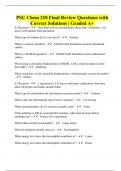
-
PSU Chem 210 Final Review Questions with Correct Solutions | Graded A+
- Exam (elaborations) • 3 pages • 2023
-
Available in package deal
-
- $8.99
- + learn more
E2 Reaction - One-Step with no intermediates, Base takes off proton + LG leaves with double bond formation. What type of carbons do E2 rxns favor? - Tertiary What is a Zaitsev product? - Double bond formation on more substituted carbon What is a Hoffman product? - Double bond formation on less substituted carbon When using a stericallly hindered base (t-BuOK, LDA), which product is more favorable? - Hoffman When using Eto- or less sterically hindered base, which pro...
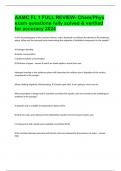
-
AAMC FL 1 FULL REVIEW- Chem/Phys exam questions fully solved & verified for accuracy 2024
- Exam (elaborations) • 24 pages • 2024
- Available in package deal
-
- $14.99
- + learn more
In the chromatography of the reaction mixture, water absorbed on cellulose functioned as the stationary phase. What was the principal factor determining the migration of individual components in the sample? A.Hydrogen bonding B.Solute concentration C.Stationary phase concentration D.Thickness of paper B and D are dumb options. Knock them out. hydrogen bonding to the stationary phase will determine the relative rate of migration of the various components in the sample. When thinking ...

-
Organic Chemistry - Final Exam 100% Correct!
- Exam (elaborations) • 6 pages • 2024
- Available in package deal
-
- $15.99
- + learn more
Name the 6 polar aprotic solvents - ANSWERacetone, acetonitrile, DMSO, DMF, HMPA, THF Name the 5 polar protic solvents - ANSWERacetic acid, ethanol, formic acid, methanol, water ______ and ______ mechanisms are two step reactions that have _____ intermediates. - ANSWERSN1; E1; 2 Intermediates each ______ and ______ mechanisms are one step reactions that have _____ intermediates. - ANSWERSN2; E2; 1 Intermediate each Allylic - ANSWERresonance stabilized (carbon bonded directly to a C=C...
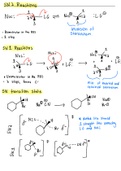
-
CHEM 210 Exam 3 Study Guide
- Summary • 7 pages • 2022
-
- $3.99
- 1x sold
- + learn more
This study guide will help you get an A on Exam 3 in CHEM 210 :) It is a summary of Exam 3 content containing colorful diagrams, drawings, and mechanisms. This study guide paired with practice problems will help any student succeed in this course. The study guide contains information from Exam 3 including: -SN2 and SN1 reactions (and transition state) -E2 and E1 reactions -Reaction rate (how it is affected by solvents, temp., strength of nuc:) -How to generate better leaving groups (tosyl...
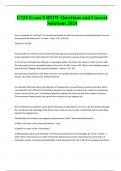
-
C325 Exam 5 HMW Questions and Correct Solutions 2024
- Exam (elaborations) • 5 pages • 2024
- Available in package deal
-
- $10.49
- + learn more
C325 Exam 5 HMW Questions and Correct Solutions 2024 Give an example of a half-cell. The absolute potential of a half-cell cannot be measured directly. How can the potential be measured? - Answer -Cu(s)| Cu2+ (0.05 M) Sn(s)|Sn2+ (0.1M) The potential of a half cell can be measured indirectly by connecting the half cell to another half cell of known potential. If the other half cell is the SHE, the potential measure will be the "standard potential". A salt of two monovalent ions M and A i...
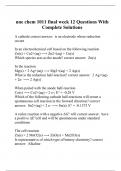
-
une chem 1011 final week 12 Questions With Complete Solutions
- Exam (elaborations) • 2 pages • 2023
-
Available in package deal
-
- $11.49
- + learn more
A cathode correct answer: is an electrode where reduction occurs In an electrochemical cell based on the following reaction Zn(s) + Cu2+(aq) ⟶ Zn2+(aq) + Cu(s) Which species acts as the anode? correct answer: Zn(s) In the reaction Mg(s) + 2 Ag+(aq) ⟶ Mg2+(aq) + 2 Ag(s) What is the reduction half-reaction? correct answer: 2 Ag+(aq) + 2e- ⟶ 2 Ag(s) When paired with the anode half-reaction Co(s) ⟶ Co2+(aq) + 2 e-; E° = -0.28 V Which of the following cathode half-reactions...
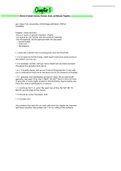
-
FGCU Organic Chemistry 1 Complete Note Set - Dr. Paull
- Class notes • 91 pages • 2023
-
- $20.49
- 1x sold
- + learn more
Dr. Daniel Paull's Organic Chemistry 1 class notes, including resonance structures, polarity, nomenclature, electron-pushing arrows, SN1 reactions, SN2 reactions, E1 reactions, E2 reactions, and reaction mechanisms, pka's.

Do you wonder why so many students wear nice clothes, have money to spare and enjoy tons of free time? Well, they sell on Stuvia! Imagine your study notes being downloaded a dozen times for $15 each. Every. Single. Day. Discover all about earning on Stuvia


